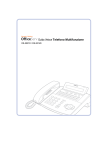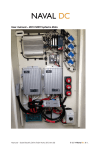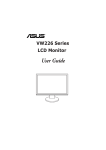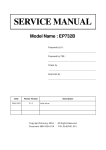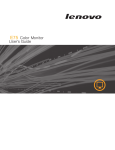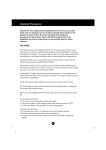Download LG Studioworks 78T5 (White) 17 in.CRT Conventional Monitor
Transcript
Colour Monitor USER GUIDE BENUTZERHANDBUCH MANUEL D'UTILISATION GUIDA UTENTE GUIA DEL USUARIO MODEL : StudioWorks 78T5 Introduction.........................................................................................1 Monitor Registration ...........................................................................2 Important Precautions ........................................................................3 Connecting the Monitor ......................................................................5 Location and Function of Controls......................................................9 User Control ....................................................................................10 OSD Adjustment...............................................................................11 Self Diagnostics................................................................................16 Energy Saving Design......................................................................16 Video Memory Modes ......................................................................17 Display Data Channel (DDC) ...........................................................19 Troubleshooting Tips ........................................................................20 Service .............................................................................................21 Specifications ...................................................................................22 Environmental Labelling of Personal Computers ................................24 TCO’95 Environmental Requirements ...................................................26 English Table of Contents English Introduction Thank you for purchasing an LG high resolution monitor. It will give you high resolution performance and convenient reliable operation in a variety of video operating modes. Features The StudioWorks 78T5 is a 17-inch(15.9 inches viewable ) intelligent, microprocessor based monitor compatible with most analog RGB (Red, Green, Blue) display standards, including IBM PC®, PS/2®, Apple®, Macintosh®, Centris®, Quadra®, and Macintosh II family. It can also be used with a Sun SPARC workstation as well as other sources using the 5 BNC connectors. The monitor provides crisp text and vivid color graphics with VGA, SVGA, XGA, VESA Ergo modes (non-interlaced), and most Macintosh compatible color video cards when used with the appropriate adapter. The monitor's wide compatibility makes it possible to upgrade video cards or software without purchasing a new monitor. Digitally controlled auto-scanning is done with the microprocessor, for horizontal scan frequencies between 30 and 85KHz, and vertical scan frequencies between 50 and 120Hz. The microprocessor based intelligence allows the monitor to operate in each frequency mode with the precision of a fixed frequency monitor. The microprocessor based digital controls allow you to conveniently adjust a variety of image controls by using the OSD (On Screen Display). The monitor is shipped with 8 factory pre-programmed video modes that are permanently resident. In addition. there are 24 user storable modes, for a total of 40 memory modes. This monitor is capable of producing a maximum horizontal resolution of 1600 dots and a maximum vertical resolution of 1280 lines. It is well suited for CAD work and sophisticated windowing environments. For greater user health and safety, this monitor complies with the stringent Swedish TCO '95 requirements for low radiation emissions. For low cost of monitor operation, this monitor is certified as meeting the EPA Energy Star requirements, and utilizes the VESA Display Power Management Signalling (DPMS) protocol for power saving during non-use periods. 1 Monitor Registration The model and serial numbers are found on the rear of this unit. These numbers are unique to this unit and not available to others. You should record requested information here and retain this guide as a permanent record of your purchase staple your receipt to this page. Date of Purchase Dealer Purchased From Dealer Address Dealer Phone No. Model No. Serial No. : : : : : : Notice All rights reserved. Reproduction in any manner, in whole or in part, is strictly prohibited without the written permission of LG Electronics Inc. Trademark Acknowledgments LG is a trademark of LG Electronics Inc. IBM is a registered trademark and VGA is a trademark of International Business Machines Corporation. WARNING : To reduce the risk of fire or electric shock, do not expose this appliance to rain or moisture. AVERTISSEMENT : Ne pas placer cet appareil dans un endroit humide. Cela peut entraîner un incendie ou une décharge électrique. 2 Important Precautions This unit has been engineered and manufactured to assure your personal safety, but improper use can result in potential electrical shock or fire hazard. In order not to defeat the safeguards incorporated in this monitor, observe the following basic rules for its installation, use and servicing. Also follow all warnings and instructions marked directly on your monitor. On safety 1. Use only the power cord supplied with the unit. In case you use another power cord, make sure that it is certified by the applicable standards(UL/CSA or VDE) if not being provided by the supplier. 2. Operate the monitor only from a power source indicated in the specifications of this manual or listed on the monitor. If you are not sure what type of power supply you have in your home, consult your dealer. 3. Overloaded AC outlets and extension cords are dangerous. So are frayed power cords and broken plugs. They may result in a shock or fire hazard. Call your service technician for replacement. 4. DO NOT OPEN THE MONITOR. There are no user serviceable components inside. There are Dangerous High Voltages inside, even when the power is Off. Contact your dealer If the monitor is not operating properly. 5. To avoid personal injury : Do not place the monitor on a sloping shelf unless properly secured. Use only a stand recommended by the manufacturer. Do not try to roll a stand with small casters across thresholds or deep pile carpets. 6. To prevent Fire or Hazards: Always turn the monitor Off if you leave the room for more than a short period of time. Never leave the monitor On when leaving the house. 3 Keep children from dropping or pushing objects into the monitor's cabinet openings. Some internal parts carry hazardous voltages. Do not add accessories that have not been designed for this monitor. During a lightning storm or when the monitor is to be left unattended for an extended period of time, unplug it from the wall outlet. Do not bring magnetic devices such as magnets or motors near the picture tube. On installation 1. Do not allow anything to rest upon or roll over the power cord, and do not place the monitor where the power cord is subject to damage. 2. Do not use this monitor near water such as near a bathtub, washbowl, kitchen sink, laundry tub, in a wet basement, or near a swimming pool. 3. Monitors are provided with ventilation openings in the cabinet to allow the release of heat generated during operation. If these openings are blocked, built up heat can cause failures which may result in a fire hazard. Therefore, NEVER: Block the bottom ventilation slots by placing the monitor on a bed, sofa, rug, etc. Place the monitor in a built-in enclosure unless proper ventilation is provided. Cover the openings with cloth or other material. Place the monitor near or over a radiator or heat source. On cleaning Unplug the monitor before cleaning the face of the picture tube. Use a slightly damp (not wet) cloth. Do not use an aerosol directly on the picture tube because overspray may cause electrical shock. On repacking. Do not throw away the carton and packing materials. They make an ideal container in which to transport the unit. When shipping the unit to another location, repack it in its original material. 4 Connecting the Monitor On the back of the monitor are three plug-in connections: one for the AC power cord, and the others, for the signal cable from the video card. 1. AC Power Connection One end of the AC power cord is connected into the AC power connector on the back of the monitor. The other end is plugged into a properly grounded three-prong AC outlet. The monitor's auto-sensing power supply can automatically detect 100-120V AC or 200-240V AC, 50 or 60Hz. 2. Signal Cable Connection The connectors for the signal cable are located on the back of the monitor. The BNC and 15 pin VGA connectors on the back of the monitor allow for a wide variety of video controllers to be connected to the monitor. Examples of signals that might be sent to the monitor include signals from IBM PC and compatibles, Apple Macintosh, Centris, Quadra and SPARC workstations. The supplied signal cable consists of 15 pin VGA connectors at both ends, suitable for connections to an IBM PC or compatible. Other generic cables or adapters may be used for connections to your equipment, as long as they meet the compatible signal requirements to activate this monitor (see page 22 for input specifications). For Apple Macintosh use, a separate plug adapter is needed to change the 15 pin high density (3 row) D-sub VGA connector on the supplied cable to a 15 pin 2 row connector. Examples of typical connections are shown below. Select the connection example that fits your needs. 5 A) Connection to any IBM VGA PC compatible system Figure 3 shows the signal cable connections from the monitor to the Video Graphics Array (VGA) port typical in an IBM PC or PC compatible. This also applies to any graphics video card for PC-CAD or workstation that has a 15 pin high density (3 row) D-Sub connector. 1. Power off both the monitor and PC. 2. Connect the 15 pin VGA connector of the supplied signal cable to the output VGA video connector on the PC and the matching input connector on the rear of the monitor. The connectors will mate only one way. If you cannot easily attach the cable, turn the connector upside down and try again. When mated, tighten the thumbscrews to secure the connection. (Rear of Monitor) R G B H+V V Signal Cable 3. Power ON the PC, then the monitor. 4. If you see the "SELF DIAGNOSTIC" message, check the signal cable and connectors. 5. After using the system, power OFF the monitor, then the PC. Computer VGA Compatible PC System D-15P D-15P Power Cord Signal Cable Figure 3. 6 B) Connecting to an Apple Macintosh II, Centris and Quadra Figure 4 shows the connection to an Apple Macintosh, using a separately purchased adapter. 1. Power OFF both the monitor and the PC. 2. Connect the 15pin VGA connector of the supplied signal cable to the matching input on the back of the monitor. Tighten the thumbscrews to secure the connection. (Rear of Monitor) R G B H+V V Signal Cable 3. Locate the appropriate MAC to VGA adapter block at your local computer store. This adapter changes the high density 3 row 15 pin VGA connector to the correct 15 pin 2 row connection to mate with your MAC. Attach the other end of the signal cable to the side of the adapter block with 3 rows. 4. Connect the attached adapter block/signal cable to the video output on your MAC. 5. Power ON the PC, then the monitor. 6. If you see the "SELF DIAGNOSTICS" message, check the signal cable and connectors. 7. After using the system, power OFF the monitor, then the PC. Computer Apple Macintosh ADAPTER 15P D-15P Signal Cable Power Cord Figure 4. 7 Notes on using the BNC connectors with other types of video cards. Follow the example that fits your needs. (BNC cables not included with Monitor.) IN CASE OF EXTERNAL COMPOSITE SYNC SIGNAL: Connect R, G and B video signals and Composite sync signal to BNC receptacles on rear panel, respectively. R G Red B Green H+V Blue V Gray IN CASE OF SEPARATE HORIZONTAL AND VERTICAL SYNC SIGNALS: Connect R, G and B video signals and horizontal and vertical sync signals to BNC receptacles on rear panel respectively. R G Red B Green H+V Blue 8 Gray V Black Location and Function of Controls Front View Power ON/OFF Switch OSD on/off Enter button Power (DPMS) Indicator Contrast Adjustment Control OSD Select/Adjustment Control Brightness Adjustment Control Rear View ID Label D-Sub Signal Connector AC Power Socket BNC Signal Connectors 9 Control Panel Function All functions are adjusted from the microprocessor based digital controls. Power Indicator OSD ON/OFF Enter Button Power Button Brightness OSD Select /Adjust Control Contrast Increase Increase Decrease Decrease Buttons on the front of the monitor allow you to easily adjust image through an OSD menu. As you choose controls, the selected icon shows you what the chosen control will do. These pictures give you immediate understanding of the controls. The following is a description of use for each button. Power On/Off button This button is used to turn the monitor on and off. In case the monitor is in a stand-by mode, indicated by an amber color Power Indicator, push the Power Button again to return the monitor to its normal display operation. Power Indicator This Indicator lights up green when the monitor operates normally. If the monitor is in DPM (Energy Saving) mode (stand-by/suspend/ power off), this indicator color changes to amber. Contrast control Adjust the display to the contrast desired. Move the thumbwheel located beneath this indicator to increase or decrease the display contrast. Brightness control Used to adjust the brightness of the screen. Move the thumbwheel located beneath this indicator to increase or decrease the display brightness. Enter button Use this button to start/enter and exit from the On Screen Display (OSD). If there is no OSD on the screen, One Click (press) of this button will show the Main Menu. To remove the display, either wait 10 seconds or double Click this button. If you are in a submenu, a single click will back you out to the Main Menu display, and then double Click will exit the menu. 10 Adjustment Control Use this knob for selecting (highlighting) an OSD icon to be adjusted. It is also used for selecting the level of the selected item to be adjusted. On Screen Display (OSD) Control Adjustment Making adjustments to the image size, position and operating parameters of the monitor are quick and easy with the On Screen Display Control system, using only the Enter button and Adjustment Control knob. A quick example is given below to get you familiar with the use of the controls. Following this section is an outline of the available adjustments and selections you can make using the OSD. Example: Note: (Monitor and PC should be ON, with an image or prompt on the screen) Rotating the Adjustment Control knob clockwise one Click will present you with the Main Menu1 of the On Screen Display system, with the first item " "highlighted. The main picture area will also show the selected icon and a brief description (here H-SIZE). If you turned the control more than one Click, a different icon may be highlighted. Move the control until the " " icon is selected. The OSD system should look like : H-SIZE enter : select: To adjust this item, press the Enter Button once. The display will look like: H-SIZE 127 1280 X 1024 main : 75Hz adjust: 11 The bar graph shows you the current level of the selected "H-SIZE" control. The OSD also tells you the resolution mode you are using and the refresh rate. Use the Adjustment control knob to increase or decrease the level to fit the screen or your desired size. When you are done, press the Enter ( ) button once to return to Main Menu1 to make another selection. If you are completely done using the OSD after you have returned to Main Menu1, you can double Click the Enter button to exit the OSD. OSD Adjustment and Selection Items In the previous section, you were introduced to the procedure of selecting and adjusting an item using the OSD system. There are two Main Menu pages: the first one has the 8 most commonly used items, and the second page has items that are used less frequently. When selecting an item to be adjusted, moving the adjustment control past the last icon on the screen (either left or right) will take you to the other Main Menu page. Listed below are the icons, icon names and icon descriptions of the items that are shown on the Main Menu1 OSD : Horizontal Width (To adjust image width) Horizontal Position (To move picture image left and right) Vertical Height (To adjust image height) Vertical Position (To move image up and down) Side Pincushion (To correct the bowing in and bowing out of the image) Trapezoid (To correct geometric distortion) Tilt (To correct image rotation) Parallelogram (To correct geometric distortion) Listed below are the icons, icon names and icon descriptions of the items that are shown on the Main Menu2 OSD : OSD Color Select (To select Color Temperature or set color levels) Zoom Adjust (To Adjust image width and height at same time) Video Level (To select input signal level (0.7V or 1.0V)) OSD Adjust (To adjust position and size of the OSD) Option Select (To select options (beep on/off, degauss, BNC/D-SUB)) Mode Recall (To recall the stored factory mode) Mode Info (To review detail about current video mode) Absence message (To notice on using) 12 Adjusting the controls for the first 8 items on Main Menu1 follow the sample procedure shown on page 12. For items on Main Menu2, examples below show how to adjust or select the possible options. In general, to adjust items in Main Menu2 1. Rotate adjustment control thumbwheel until the desires icon is shown and is highlighted. 2. Click the Enter Button to confirm that selection. A new submenu will present you with options. 3. Rotate the adjustment control thumbwheel to select the desired setting or level. 4. To exit, click the enter button once. This will take you back to the MainMenu. you can select another icon to adjust by rotating the adjustment control thumbwheel, or exit the MainMenu by doubleclicking the enter button. COLOR SELECT This item allows you to select the display's color temperature or adjust your own user color levels. Push the Enter Button. The color selection as shown below will be displayed. Select the desired color temperature or select user to set your own color levels. Press the Enter Button when done. ? OSD color 9300 K enter : ? OSD color select select: select 7200 K user enter: select: ZOOM ADJUST This item allows you adjust both width and vertical size of the image at the same time.After highlighting this icon push the Enter Button, the zoom adjust as shown below will be displayed. Rotate the adjustment control to adjust the display size. Press the Enter Button when done. ? OSD zoom ? OSD adjust zoom adjust 68 enter : main : select: 13 adjust: VIDEO LEVEL This item is used to select the monitor's input signal level. The normal level used for most PC's is 0.7V. After highlighting this icon, press the enter button. Select the desired level with the adjustment control to highlight the desired level. Press the enter way when done ? OSD video 0.7V enter : level 1.0V select: OSD OSD ADJUST This item lets you adjust the OSD position and size. After selecting the OSD icon using the Adjustment Control, push the Enter Button. The OSD will be displayed as shown below. Select an icon using the Enter Button. Rotate the Adjustment Control to modify existing position or size. Press Enter when done. ? OSD OSD enter : ? OSD adjust OSD select : select: adjust main : For example, if the selected signal input is BNC in D-SUB, the picture is muted and in DPM for a few second. Then if a micom confirms the input signal jack, the input signal searches for D-SUB again so that the picture is automatically displayed. When this icon is selected, the OSD appears as shown below. This message indicates the monitor is on processing even though you are away for some time due to another matter. The message does not disappear until you click the enter key again. 14 OPTION SELECT This item gives access to 3 elements ; manual degaussing, beep ON/OFF and signal input selection. Press the Enter Button to select the desired item to change. Rotate the adjustment control to either perform the function highlighted or select the desired item. Press Enter when done. option ? OSD option select select : Degauss beep : : BNC D-SUB enter : select : select: main : MODE RECALL This item recalls and restores your display to one of the factory preset modes. After highlighting this icon, press the Enter Button and the image will revert to one of the factory presets. The information shown on-screen will include video memory mode number and the horizontal and vertical refresh rate for that mode. To exit this item, double click the Enter Button. Recall mode OK no 31.5KHz : / 2 60Hz MODE INFORMATION This item provides information about the stored video modes. After highlighting the mode information icon, press Enter. Rotate the Adjustment Control to see the desired video mode information. The mode information screens give you some information regarding industry resolution terminology, resolution and memory mode number. ? OSD mode mode info. information V e s a 8 0 0 S V G A x 6 0 0 p r e s e t m o d e u s e r m o d e m o d e d a t a : enter : 3 : : main : select: 15 8 12 ABSENCE MESSAGE When this icon is selected, the OSD appears as shown below. This message indicates the monitor is on processing even through you are away for some time due to another matter. The message does not disappear until you click the enter key again. Notice On processing Self Diagnosis The Studioworks 78T5 has a SELF DIAGNOSIS OSD feature that pops up when there may be possible causes of non-operation. The OSD would highlight a possible reason the display is not showing an image. An example of this may be when you turn on the monitor with no signal cable attached. The monitor will display the SELF DIAGNOSIS OSD with the "CHECK input signal". This would be a clue for you to check the signal connections. Energy Saving Design This monitor complies with the EPA's Energy Star program, which is a program designed to have manufacturers of computer equipment build circuitry into their products to reduce power consumption during time of non-use. This monitor also goes into its energy saving mode if you exceed the monitor's operating limits, such as the maximum resolution of 1600x1280 or the frequency refresh rates of 30-85 KHz horizontal or 50-120Hz vertical. When this monitor is used with a "Green" or EPA Energy Star PC, or a PC with a screen blanking software following the VESA Display Power Management Signalling (DPMS) protocol, this monitor can conserve significant energy by reducing power consumption during periods of non-use. When the PC goes into the energy saving mode, the monitor will go into a suspended operation state, indicated by the Power LED light changing from a green color to an amber color. After an extended period in the suspended mode, the monitor will then enter a semi-OFF mode to conserve more energy. In the semi-OFF mode or DPMS OFF mode as we call it in our specifications, the Power LED will still show an amber color. When you awaken your PC by hitting a key or moving the mouse, the monitor will also awaken to its normal operating mode, indicated by the green Power LED light. By following these conventions, the power consumption can be reduced to the following levels: Normal operation : Maximum 120 Watts Suspend mode : 15 Watts DPMS Off : 5 Watts. 16 Video Memory Modes This multi-synchronous auto-scanning monitor can automatically detect and display several video modes. For convenience, the monitor has a 40 mode memory of which 8 modes come from the factory preset to popular video modes as described below. Resolution H-Freq. V-Freq. HS. pol VS. pol Mode 720 x 400 640 x 480 640 x 480 800 x 600 1024 x 768 1280 x 1024 1152 x 870 1280 x 1024 31.47KHz 31.47KHz 37.50KHz 46.88KHz 60.02KHz 63.98KHz 68.68KHz 79.98KHz 70.08Hz 59.94Hz 75.00Hz 75.00Hz 75.03Hz 60.02Hz 75.06Hz 75.03Hz + + + + + + + + + 1 2 3 4 5 6 7 8 Modes 17-40 are empty and can accept new video data. If the monitor detects one of the above signals from your computer's video card, it will recall that mode and any stored image adjustments you may have made before. If the monitor detects a new video mode that had not been present before or not one of the above listed factory presets, it will store a new mode automatically in one of the blank (empty) memory modes (in this example, mode 17). When you now adjust the digital controls to your preference, these image settings will also be stored in mode 17. Whenever your video card or PC switches to the mode that the monitor recognizes as mode 17, your personal image settings will also be recalled. 17 A note about the video memory modes: There is a total of 40 video memory modes, generally more modes than you will use at any one time. Of these 40 modes, 8 are permanent, factory fixed modes that cannot be changed, and another 8 are set at the factory, but may be overwritten to make more room. The remaining 24 modes are left blank (empty). If you use up the 24 blank modes and still have more new video modes, the monitor will store information in the other 8 soft preset modes for the new mode storage. If additional new modes are encountered, the monitor will delete the lowest memory mode and add the new mode. If you use a video card that has a number of resolutions and frequencies that do not correspond to any of the monitor video modes set at the factory, here's what will happen: 1) As the monitor encounters new video data, if you adjust the image control icons, the monitor will save the new information in the next available empty mode (mode 17 if this is the first new data encountered). 2) If you have used modes 17-40 with 24 new video modes, and the monitor encounters another mode (41th mode), it will store the new data in mode 17 and the old data of mode 17 is deleted. In addition, If the monitor encounters 42th new video data, the old data of mode 18 is deleted and 42th data will replace the mode 18, with above method, when this monitor encounters new mode, it can update from mode 17 to mode 40 sequentially and continuously. mode Example:All 40 modes are filled with following data data 1 2 3 4 5 6 7 8 9 10 11 12 13 14 15 16 17 18 19 38 39 40 m1 m2 m3 m4 m5 m6 m7 m8 m9 m10 m11 m12 m13 m14 m15 m16 m17 m18 m19 m38 m39 m40 Factory fixed Soft presets When new data is encountered 1 2 3 4 5 6 7 8 9 10 11 12 13 14 15 16 17 18 19 38 39 40 m1 m2 m3 m4 m5 m6 m7 m8 m9 m10 m11 m12 m13 m14 m15 m16 m17 m18 m19 m38 m39 m40 Factory fixed "m17"old mode 17 deleted Because the monitor is designed this way, you will always have the most common 32 video modes generated by your graphics card available with your own image settings recalled automatically. 18 Display Data Channel (DDC) This monitor complies with the VESA (Video Electronics Standard Association) DDC type 2B specification, a new standard allowing a compatible video card 2-way communication with the monitor. This communication includes automatic setup (sometimes referred to as Plug and Play) of the optimum resolution available to both the video card and monitor. If your PC has Windows 95 and a DDC compatible video card, your PC will automatically determine the optimum match for the video display controller and monitor. No further setup of the display selection or resolution is needed. If you do not have a PC with a DDC compatible video card, further setup in Windows may be necessary for the optimum display between resolution desired, number of colors and refresh rate. 19 Troubleshooting Symptom: Self diagnostics message. Possible causes: The signal cable is not connected. Symptom: The power led is illuminated amber. Possible causes: Display power management mode. (Move mouse to awaken PC.) Check the computer power and graphics adapters configuration. The frequency of the sync input is outside the operating range of the monitor. Monitor Input Limits HORZ:30KHz-85KHz VERT:50Hz-120Hz The signal cable is incorrectly configured or connected Refer to the page Signal connector pin assignment for reference. Symptom: Image is not correctly shaped Possible causes: A new mode is selected. User control has not yet been adjusted. Use the controls to adjust image. Refer to Location and Function of controls. 20 Service 1. Unplug the monitor from the wall outlet and refer servicing to qualified service personnel when: The power cord or plug is damaged or frayed. Liquid has been spilled into the monitor. The monitor has been exposed to rain or water. The monitor does not operate normally following the operating instructions. Adjust only those controls that are covered in the operating instructions. An improper adjustment of other controls may result in damage and often requires extensive work by a qualified technician to restore the monitor to normal operation. The monitor has been dropped or the cabinet has been damaged. The monitor exhibits a distinct change in performance. Snapping or popping from the monitor is continuous or frequent while the monitor is operating. It is normal for some monitors to make occasional sounds when being turned on or off, or change video modes. 2. Do not attempt to service the monitor yourself, as opening or removing covers may expose you to dangerous voltage or other hazards. Refer all servicing to qualified service personnel. 3. When replacement parts are required, have the service technician verify in writing that the replacements used have the same safety characteristics as the original parts. Use of manufacture specified replacements can prevent fire, shock, and other hazards. 4. Upon completion of any service or repairs to the monitor, ask the service technician to perform the safety check described in the manufacturer's service manual. 5. When a video monitor reaches the end of its useful life, improper disposal could result in a picture tube implosion. Ask a qualified service technician to dispose of the monitor. 21 Input Specifications Sync signal types Priority Type H. Sync. V. Sync 1 2 Separate sync. Composite sync. H. Sync. H/V Sync. V. Sync. N.C (N.C : no connection) D P M (Display Power Management) MODE H. Sync V. Sync Normal Stand by Suspend Off On Off On Off On On Off Off Power Consumption 120W 15W 15W 5W LED Color Green Amber Amber Amber Signal connector pin assignment 1 2 1 11 Pin 1 2 3 4 5 6 7 8 9 10 11 12 13 14 15 3 4 5 5 6 10 15 Signal (D-Sub) Red Green Blue Optional Self-Test Red Ground Green ground Blue Ground Not used Ground Ground Bi-Dir. DATA H. Sync V. Sync DATA Clock Pin 1 2 3 4 5 Signal (5 BNC) Red Green Blue H. Sync (H or H+V) V.sync 22 Color Red Green Blue Gray Black Specification Picture tube 17 inch (15.9 inches viewable ), 90 degree deflection, Dark face, 0.26mm dot pitch TCO-Coating. Sync Input Horizontal Freq. : 30KHz-85KHz (Automatic) Vertical Freq. : 50Hz-120Hz (Automatic) Input Form : Separate, TTL, positive/negative Composite, TTL, positive/negative Signal input : 15pin D-Sub connector/5 BNC connector Video Input Display Area : 300x225 mm/11.8"x8.9"(HxV) Input Form : Separate, RGB Analog, 0.7Vp-p/75 ohm, positive Power Input 100-240V AC 60/50Hz 2.0A Power Consumption : 120 Watts Max 15 Watts Suspend /Stand-by mode 5 Watts DPMS-off mode Dimensions (WxHxD) 16.2" x 16.9" x 17.0" (with tilt/swivel stand) Weight (net) 18.7Kg (41.2 lbs) Information in this document is subject to change without notice and does not represent a commitment on the part of LG Electronics Inc. 23 MODEL : StudioWorks 78T 78T P/NO : 3828TUL001J(S-9604) Printed in Korea FCC Compliance Statement This equipment has been tested and found to comply with the limits for a Class B digital device pursuant to Part 15 of the FCC Rules. These limits are designed to provide reasonable protection against harmful interference in a residential installation. This equipment generates, uses and can radiate radio frequency energy and if not installed and used in accordance with the instructions, may cause harmful interference to radio communications. However, there is no guarantee that interference will not occur in a particular installation. If this equipment does cause harmful interference to radio or television reception (Which can be determined by turning the equipment off and on), the user is encouraged to try to correct the interference by using one or more of the following measures: - Reorient or relocate the receiving antenna. - Increase the separation between the equipment and the receiver. - Connect the equipment into an outlet on a circuit different from that to which the receiver is connected. - Consult the dealer or an experienced radio/TV technician for help. Caution: Changes or modifications not expressly approved by LG Electronics Inc. for compliance could void the user's (or your) authority to operate the equipment. Only peripherals (digital input/output devices, terminals, printers, etc.) certified to comply with the Class B limits may be attached to this monitor. Operation with non-certified peripherals is likely to result in interference to radio and TV reception. Only shielded Signal Cables may be used with this System. Canadian D. O. C Notice This Class B digital apparatus meets all requirements of the Canadian Interference-Causing Equipment Regulations. Cet appareil numérique de la classe B respecte toutes les exigences du Règlement sur le matériel brouilleur du Canada. D E C L A R AT I O N O F C O N F O R M I T Y We LG Electronics Inc. 184 Kongdan-dong, Kumi-city Kyoungbuk, Korea declare under our sole responsibilty that the product Colour Display Monitor Model : StudioWorks 78T5 to which this declaration relates is in conformity with the following standard or other normative documents: EN 50082-1/1992, EN 55022/1987, EN 60555-2,-3/1987 following the provisions of the EMC Directives 89/336/EEC, 92/31/EEC and 93/68/EEC. Monitor OBU, Kumi Plant LG Electronics Inc. Korea Kumi, October 20, 1995 (place and date of issue) D.H.Jeong, Manager (Name and signature of authorized person)





























